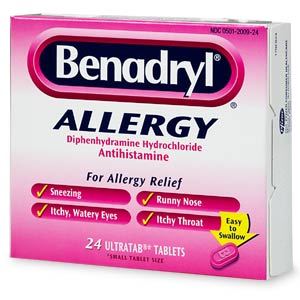We often get asked if Benadryl is safe and effective for dogs.
This question is super common during allergy season! In any case, you’ll happy to hear that, yes, this antihistamine can be given.
Benadryl has a good safety record with regards to animals. In fact, many dogs take it without incident.
 Of course, that isn’t to say that side effects don’t occur.
Of course, that isn’t to say that side effects don’t occur.
Keep reading to learn more….
Dogs Can Take Benadryl
Also known as Diphenhydramine, this popular medication also works for pets.
Most vets view OTC Benadryl as an acceptable option because it is typically well-tolerated.
With that being said, consider these points before we talk dosing:
- Frequent use of Benadryl, regardless of the intended purpose, should be avoided.
- Some dogs may be at too high a risk. Extra caution is required for those with cardiovascular disease, glaucoma or elevated blood pressure.
- Benadryl is not an option for puppies or for dogs with serious and/or recurring allergies.
How To Dose Your Dog
Obviously it’s key to get the amount right.
A safe Benadryl dose should factor in breed, medical history, weight and symptoms.
So how much exactly?
A rule of thumb is 1mg for each pound of a dog’s body weight up to 3 times daily. To be exact, you may need to break up pills.
FYI: This antihistamine should be provided on a full stomach.
Why It’s Pretty Good
Relative to similar drugs, Benadryl has established itself as being one of the better medications for pets.
Over-the-counter Benadryl contains Diphenhydramine (normally non-lethal).
This contrasts with pseudoephedrine as well as acetaminophen which are both easily toxic, even deadly!
Do Not Depend On It
Despite the favorable safety profile, you should avoid medicating whenever possible.
Seriously! Giving your dog Benadryl is not as routine as human use.
Play it safe!
Have unmanageable or recurring allergies checked out. Avoid experimenting.
It’s Not an Actual Fix
Here’s a reality check:
Diphenhydramine, and drugs like Benadryl, can’t cure your dog’s allergies.
There is only one real solution and that is to eliminate the source(s).
It could be food. It could be airborne, or even something they rubbed up against.
What’s certain is treating only symptoms is not a sustainable plan.
There are Alternatives
A Benadryl alternative, one that can safely sooth your dog’s skin, is an anti-itch hot-spot spray.
For dry nose or cracked paws try this:
An organic moisturizer (one that’s designed for dogs).
Other Benadryl Uses
Benadryl reduces motion sickness. It works for dogs for this purpose too.
But a fearful or agitated pet probably shouldn’t be taking Benadryl.
What about using Diphenhydramine as a sedative?
This JAVMA study of 56 dogs found (quite surprisingly) that it’s not great for this intended purpose.
Look into Melatonin instead.
Look For Certain Signs
While not considered high-risk, Benadryl can sometimes make matters worse.
Hey, it’s the nature of medicines!
Watch for side effects (especially the first time you give your dog Benadryl).
Known reactions include:
- Vomiting
- Diarrhea
- Poor appetite
- Dry mouth
- Decreased urination
If An Accident Occurs
Your vet’s assistance is required for a suspected Benadryl overdose.
How many milligrams did your dog consume? Over what period of time?
That type of info is critical for a veterinarian. Take notes!
The Bottom Line
Benadryl can generally be given to dogs.
The drug reduces allergies, but keep in mind that eliminating allergy stimulants will always be the optimal approach.
When utilizing Benadryl, it is essential that your dog receive a proper dose. To be safe, please consult with your vet.
